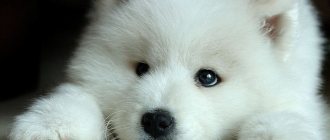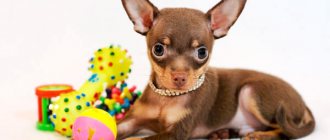If you look at the standard, it turns out that the division is not officially recognized: absolutely all Shar Peis must fit the description of the breed. The appearance of Chinese and American dogs differs from each other and from the standard. Therefore, despite the dissatisfaction of experts, judges of major international exhibitions make concessions to Shar Pei owners and turn a blind eye to slight discrepancies with the official description.
To avoid problems and maintain fairness in the competition, the judges developed an algorithm for choosing the best Shar Pei:
- all participating dogs are divided into two groups: Chinese and American type;
- One dog is selected from each group that best meets the standard;
- the winner is determined by comparing the two group leaders.
Chinese Shar Peis become champions more often than American ones - due to their greater compliance with standards.
Description of the breed
The Chinese Shar Pei is a medium-sized dog with a strong build, covered with folds of varying depths. Breeders from the Middle Kingdom, unlike their American colleagues, recognize only individuals with the shortest type of coat - horse. The length of the hairs on the animal’s body cannot exceed 1 centimeter.
To understand how the “Chinese” differ from the “Americans”, comparison is indispensable. The main differences are:
- the Chinese type is more squat and stocky, in females the body is more elongated;
- this type has more folds, both on the head and on the body, thanks to them, Chinese Shar-Peis look plump;
- the nose of the “Chinese” is larger and more massive, the muzzle is not as toned as that of the “Americans”;
- Black and monochrome colors are not found among traditional Chinese Shar-Peis.
Famous Shar Peis
In 1979, Shar Peis became screen stars for the first time: one made his debut in a Japanese film, the other in a movie. After this, Shar Peis could be seen in “The Simpsons” (episodes “Bart’s Dog Gets a F” and “25 Greyhounds”, the animated series “Creature Comforts”), the Disney cartoon “American Dragon: Jake Long”, the television series “Stay alive" (eng. Lost), the films "The Witches of Eastwick" and "Soul Surfer" (in the final scene, the Shar Pei stands in the sea on a board with the owner). In addition, the Shar Pei puppy is used in the Garnier advertising campaign to combat wrinkles.
Violinist Vanessa Mae is a big fan of Shar Peis.[18][19] She even dedicated a composition called “Pasha” to her first Shar Pei, crushed by a motorcycle.[20] Other famous Shar-Pei owners include Kwon Ji-yong, leader of the Korean group Big Bang, and New Kids on the Block member Jonathan Knight, who toured with his Shar-Pei Nikko, whose photographs were published in numerous magazines.
History of appearance
This breed was bred for dog fighting, a popular entertainment among the common people of Ancient China from the 3rd-2nd century BC. Features that helped dogs in fights developed and were cultivated: folds and short, spiky hair for protection, powerful jaws and paws for attack.
Over time, representatives of the breed spread widely throughout the territory of the Celestial Empire and mastered new functions for themselves - protecting property, protecting the owner and hunting large animals. Shar Peis were ideal for performing these tasks.
For some unknown reason, the breeding books of Chinese Shar-Peis were destroyed by order of one of the rulers of the Celestial Empire. Because of this, much of the breed's history is based on logical calculations and assumptions.
But the date when Chinese Shar-Peis could disappear completely is clearly defined - 1949. It was at this time that the communists, who came to power in China, decided that any pets were a legacy of the hated regime. Huge taxes were imposed on the maintenance of animals, and often the unfortunate four-legged friends were simply destroyed, without regard to thoroughbredness or historical value.
After a few years, Shar Peis remained only in remote rural farms, where the owners carefully hid them from the authorities.
In 1965, a Chinese Shar-Pei puppy, Lucky, arrived in the United States, and it was he who became the impetus for the emergence of American Shar-Peis, but that is a completely different story.
After the end of the terror declared on four-legged friends, war began in communist China. The fact that after its end the old-type Chinese Shar-Peis still existed can only be described as a miracle.
In 1976, the breed standard was approved, and 9 years later, Shar Peis were recognized by the American Kennel Club. In our country, dogs of this breed appeared only in the 1990s.
Theses
- This breed was considered one of the rarest, for which it was included in the Guinness Book of Records.
- Its numbers were restored in America, but at the same time their features were significantly distorted. And today, Chinese native Shar-Peis and American Shar-Peis differ significantly from each other.
- They love children and get along well with them, but do not like or trust strangers.
- This is a stubborn and headstrong dog; Shar Peis are not recommended for people who have no experience in keeping dogs.
- Shar Peis have a blue tongue, just like Chow Chows.
- They do not get along with other animals, including dogs. We are ready to tolerate domestic cats, but only if we grew up with them.
- A small gene pool and fashion have led to the appearance of a large number of dogs with poor health.
- The condition of the breed is of concern to various organizations and they are trying to ban breeding or change the breed standard.
Breed standard
- Height at withers : males - up to 51 centimeters, females - from 40 centimeters.
- Weight : ranging from 18 to 25 kilograms.
- Lifespan : from 10 to 12 years.
- Coat : short - up to 1 centimeter, without undercoat, hard, not adjacent to the skin.
- Color : red, black, fawn, blue, lilac, red, isabella, chocolate, coffee, sable, fawn.
- Head : proportional, large, with folds.
- Ears : small, thick, triangular, rounded tips, curved forward.
- Eyes : small, almond-shaped, sunken.
- Neck : medium size, developed.
- Back : arching behind the withers and rising towards the loin, short, wide, powerful.
- Chest : Quite deep and wide.
- Tail : Tapers towards the tip, thick at the base. It twists into a ring or bends over the back without touching it.
- Forelegs : with developed, sloping, laid back shoulders. Direct. The elbows are located close to the body. Powerful and flexible. The paws are medium in size and strong.
- Hindquarters : Well muscled and moderately angulated. The short hock joints are perpendicular to the ground.
Choosing a puppy
To purchase a Shar Pei puppy, it is recommended to contact specialized nurseries or trusted breeders. It is better to buy puppies from the age of two months.
When choosing a puppy, pay attention to the following external characteristics:
- The chest should be well developed.
- The body is square (not elongated).
- Parallel placement of the front paws.
- No narrowing of the muzzle.
Check the cleanliness of the skin and the absence of discharge from the eyes and ears. A small Shar Pei should be playful and active.
To purchase a Shar Pei without documents, you will need to pay at least 8 thousand rubles. And for a baby with a good pedigree, breeders ask from 40 thousand rubles. In the US, prices for this breed range from $150 to $500.
Appearance Features
The appearance of the Chinese Shar Pei makes one think of plush toy dogs.
The many folds throughout the body cause tenderness. A frown, caused by folds in the eyes, adds additional zest to the image of a Shar Pei. The coat is rough and short, but nevertheless quite dense and feels like plush to the touch.
A feature inherent in the breed is a blue-black oral cavity. Lips, tongue, palate - such an unusual color for dogs. A similar color is found only in the Chow Chow.
Thick paws with folds add massiveness and “tower-like” appearance to the dog.
The tail does not straighten completely - the characteristic “pretzel” completes the image of the “plush” dog.
There are no white Shar Peis.
The uniform color can be lighter on the tail and under it, darker on the muzzle and spine.
Historical facts
- In the 70s of the 20th century, Shar Peis were listed on the pages of the Red Book. During this period they were the rarest breed in the world. To buy such a puppy, you had to pay a couple of thousand dollars.
- Shar Peis were often used as watchdogs and guards. But in ancient Tibet they took part in dog fights. In these latitudes the breed was called the “Chinese fighting dog.” The peculiarities of the skin, namely the presence of many folds, provided the dogs with relative safety. Because during the fight the enemy damaged the skin, but could not damage the internal organs.
Character, intelligence and behavior
A serious appearance and “frowning” can be misleading: at home, Shar Peis are the kindest dogs, loving and appreciating care and affection.
The owner is the most important thing in life.
Representatives of the breed will adapt to the mood, activities, and lifestyle of the owner. They are ready to do anything if only the owner is nearby: it doesn’t matter where - on a noisy street, in a quiet park, at home in front of the TV.
But in order for the Shar Pei to be recognized as a leader, you will have to work hard: these dogs themselves are not averse to dominating. If the owner does not insist on following commands and indulges the pet’s whims, a role change is possible, and the animal will feel like a leader.
Shar Peis are suspicious and wary of strangers. Aggressive towards foreign animals. They consider dogs as competitors, others as prey.
How children get along with a Shar Pei is a difficult question. If you already had a child when the pet came into the family, no problems are expected. But the dog perceives the appearance of a new family member with bewilderment. Older children will find in a dog of this breed a true friend, ready to share games and entertainment, and take on protection.
Calmness and friendliness are character traits that make the “Chinese” an excellent companion who can live in an apartment without any problems. But Chinese Shar-Peis are not suitable for kennel keeping - this both harms their psyche and threatens their health: short hair does not allow them to stay outside for a long time in the domestic climate.
Varieties
There are several varieties of Shar Peis:
- Chinese;
- American;
- English;
- Canadian.
Representatives of these species have similar characteristics, except for the Canadian one, which is 7 cm smaller than its counterparts.
During the selection of the breed, long-haired individuals were bred. They also have folds on their body, but due to their fluffy and voluminous fur, they are practically invisible. To this day, shaggy sharpeis remain an unrecognized species at exhibitions; only obedience displays are allowed.
Not long ago, a new species was identified - the dwarf Shar-Pei. In some countries this species is a breeding match. The birth of small dogs from standard dogs cannot be predicted. The chances of getting mini Shar-Peis are slightly higher if you breed two dwarf animals.
Training and education
Chinese Shar-Peis require early socialization. Without it, the pet will show aggression towards passers-by and other animals.
Natural distrust will be an excellent basis for developing security skills. Shar Peis are generalists, capable of combining the duties of a guard and watchman, and at the same time being a devoted friend.
These dogs learn commands well and are easy to train. But you shouldn’t relax - the Shar Pei will definitely try to find the boundaries of what is permitted and step over them.
The main thing in raising such dogs is to immediately make it clear who is in charge, and constantly maintain the title of leader, setting clear rules of behavior that the pet can understand.
Who to choose - a boy or a girl?
When choosing the gender of a puppy, you should understand that, despite the common features inherent in both male and female Shar Peis, they also have some differences.
Thus, girls are more attached to home, they are more obedient and better amenable to training, and have more developed security and watchdog instincts. Apart from the inconveniences associated with mood swings and changes in behavior that are provoked by the biannual heat cycle, female dogs do not cause problems.
Males are permanently in a state of heat and react violently to all females in heat throughout the year. They are also more stubborn, independent, and more likely to show aggression towards other dogs.
NOTE!
There are plans for the dog to participate in breeding the breed; you should buy a female.
Features of feeding
Shar Pei food allergies require caution and careful introduction of new foods.
Premium dry food should be hypoallergenic, but balanced so that the pet’s body receives all the substances necessary for health.
If your dog consumes natural products, you need to carefully monitor the serving size: the constitution is conducive to weight gain, the animal cannot limit itself.
Be sure to exclude pork and chicken from your diet, limiting yourself to beef, lamb and turkey. You can diversify your diet with porridge in water or broth, vegetables, and fish.
Price range
The cost of a puppy starts from 35 thousand rubles. It depends on the location of the nursery, the titles of the parents, the gender of the puppy, its color, age and other characteristics.
According to an advertisement or on the market, you can buy a puppy for 5-15 thousand rubles, but in this case there is no guarantee that the puppy is healthy and meets the breed standard.
Advantages and disadvantages
A long, complex history could not but affect the character of the Chinese Shar-Pei. Before adopting a puppy of this breed, you need to carefully consider the positive and negative traits inherent in the pet.
pros
- A big advantage is the adaptability of Chinese Shar-Peis to apartment living - not many medium-sized dogs feel comfortable in a limited space.
- Unusual appearance is another plus in the piggy bank. The “Chinese” will not remain without the attention of others.
- Friendliness, calm disposition, strong nervous system and commitment to cleanliness make Chinese Shar Peis excellent companions.
- Such dogs are always ready to protect both the owner and his property.
- Easy care and the absence of a characteristic “dog” smell further increase the attractiveness of the breed.
Minuses
- Allergic reactions to food and diseases inherent in the breed require increased attention from the owner to the health of the pet.
- The Shar Pei's attempts to try on the role of a leader will make the owner's life interesting, but difficult.
- Long walks are a joy if you have time, but if not, then your Shar Pei still needs them.
- A complex character will be a problem for a novice dog breeder: if there is no desire to overcome difficulties, it is better to take a dog of a different breed.
Photos with examples of colors
There is a classification of Shar Peis according to the color of their coat.
The main color suggests the presence of a black mask and “belt”. The coat can be black, cream, fawn, red fawn, isabella, red, blue (including all shades of grey) and sable.
The group of dilute colors includes cream, apricot, red, chocolate, lilac, and isabella colors. The main difference from the main colors is the complete absence of black on the pet’s coat.
Unusual colors include spotted (spots of red, blue or chocolate on a white coat) and saddleback (the back is covered with black fur with light tan).
NOTE!
Solid white coat color is unacceptable - such dogs have many hereditary pathologies.
How to properly care
- Brushing no more than three times a week - with a short hair brush. Chinese Shar-Peis do not shed and do not have an undercoat. Caring for a centimeter coat will not cause problems.
- Bathing - depending on how dirty it is, at least once every 4 months. Wash products are only hypoallergenic, so as not to harm the skin. After water treatments, dry with a hairdryer, paying special attention to folds.
- Ears need to be cleared of wax several times a week. A cotton swab and lotion will help with this procedure. It is better to pluck the hair growing in the ears to ensure free access of air.
- The claws must be trimmed every month, using a special nail clipper, if they do not get worn down during walks. Trim carefully so as not to touch the vessels.
- your eyes every morning with water or chamomile decoction to remove dirt and discharge.
- your teeth regularly to prevent plaque.
Care
They do not require special care, just regular brushing. Shar Peis shed and those with longer fur shed more often. Shorthairs shed unnoticed, except during seasonal shedding periods.
Although all types of Shar Peis have relatively short fur, they are one of the worst breeds for people with allergies.
Their fur causes attacks in allergy sufferers, and sometimes even in those who have never suffered from a dog hair allergy before.
However, if special coat care is not required, this does not mean that it is not needed at all. The peculiarity of the breed is the structure of the skin and the wrinkles on it need to be taken care of daily.
Especially those on the face, since during eating food and water get into them. The accumulation of fat, dirt and feed leads to inflammation.
Life expectancy and major diseases
Quite complex genetics have led to a whole list of diseases to which the breed is predisposed:
- amyloidosis;
- panostitis;
- bite problems;
- otitis;
- vision problems;
- dysplasia of the knee and pelvis;
- dislocations of the knee joints;
- osteodystrophy, osteochondrosis;
- swollen joints;
- a whole range of allergic reactions;
- tendency to neoplasms – both benign and malignant.
With careful care and proper maintenance, Chinese Shar-Peis live from 10 to 12 years.
What you need to know
Before starting to work on the character of his pet, the owner needs to find out what qualities a puppy must have in order to be called well-mannered and obedient. The processes of training and education have a close relationship. Training includes learning to unquestioningly carry out simple commands. You can start it immediately as soon as the puppy appears in the house (regardless of its age) and the equipment and necessary things have been purchased for it. Education involves the formation of a clear hierarchy in the family, an understanding of what the owner’s behavior should be towards the dog.
We cannot ignore everything that a well-mannered puppy and its owners should know:
- If owners want to solve difficulties associated with their pet’s behavior, they must learn the main rules of upbringing. Failure to comply with these principles becomes the main reason for their appearance.
- One of the most important skills for a pet is toilet training outside or in a certain place in the house. The puppy will not be able to deal with these issues on his own. He can acquire this skill only through training. You need to start developing good toilet habits as early as possible. And the more correct the chosen training tactics, the faster you will be able to achieve stable results.
- You need to train your pet from the moment it starts living in your home. At a minimum, he should learn and follow basic commands.
- Puppy owners can face many difficult situations. For example, if a baby fawns over strangers, they begin to fear that he will not be able to become a reliable protector. Or, perhaps, the puppy bites when trying to feed and during play. Other pets may pick up crap from the floor or flatly refuse to listen to you. If you pay attention to different aspects of education, you can solve such problems.
Simple conclusions for the owner
To raise a well-mannered and obedient puppy, you need:
- Engage with him in studying and executing commands.
- Set clear and understandable rules.
- Solve problems that arise during the education process.
- Insist on.
- Don't be afraid to use physical punishment.
- Remember that you can never have too many positive emotions and games.
- Show your dog confidence in his abilities.
- Believe that if you work and put in a lot of effort, success will come.
And the most important thing to always remember is not to worry about small failures or difficulties. After just a short period of time, you will be surprised by the positive changes in the character of your pupil. You just need to work while maintaining optimism and a good mood.











